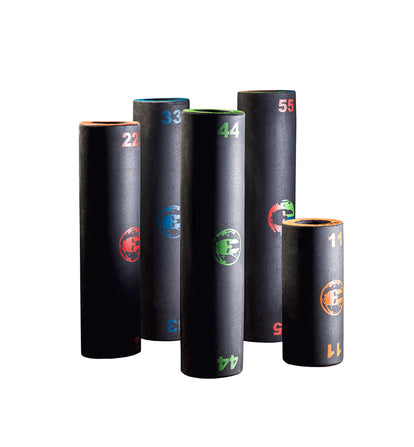The Source of Your Stress Is Complacency. Here's How to Fix It.

Recent research reveals that Americans aged between 45 and 65 years old feel more stressed out today than their compatriots of the same age group 30 years ago.
There are many reasons for this, of course, and main culprits include changes in tech, work, and family life. But a further cause? The fact that we spend less time moving than people from the past.
Related: How Stress is REALLY Affecting Your Athletic Performance
So, while the lesson here is to get off of the couch more often than not, it’s also helpful to include some stress-booting exercises into regular workouts. Acute feelings of stress can be overwhelming, but with the five Spartan-approved exercises below, you can stop being complacent, get your shit together, and do something about it.
How to Relieve Stress With Exercise
Engage the Endorphins
“Surprisingly enough, the most effective exercise sessions to help relieve stress are those where you actually don’t push your body to its limits,” Bella Skurbe, a NSCA-certified personal trainer and Spartan SGX Coach at the Philadelphia Sports Club in Chalfont, Pa., says.
Skurbe explains that for long-term stress management, strictly focusing on either low- or high-intensity exercises might not cut it.
“Low intensity may not be effective enough at long-term stress management, and high-intensity sessions can directly provoke the secretion of stress hormones like cortisol," she says. "Moderate-intensity exercise, on the other hand, produces just enough endorphins (feel good chemicals) without the cortisol.”
Related: A Racer's High Is a Psychoactive Game Changer. Here's How to Get It.
Skurbe suggests getting the heart pumping with moderate aerobic activities such as swimming, dancing, and climbing. An easy run or some time on the rower or elliptical can also help.
“As long as your heart rate doesn’t go above 70-75% of your max, this will be effective at managing stress,” she says.
Hang Tough With Isometric Holds
According to Skurbe, isometric holds are another great way to eliminate stress.
The difference between isometric and isotonic exercises is that the former involves the contraction — or tension — of muscles, but without a change in limb movement. Isotonic activity does the opposite, producing limb movement in exercises such as push-ups, pull-ups, and deadlifts, but minus a change in muscle tension.
The stress-busting ability of isometric holds comes from the fact that these exercises can improve physical endurance, as well as posture (and therefore breathing) through the strengthening and stabilization of the muscles. They enable you to notice the tension within your body and prompt you towards releasing it efficiently.
Related: 5 Science-Backed Ways That Racing Can Reduce Your Stress Level
“For isometric holds, think yoga poses, a plank, or a wall sit,” Skurbe says. “Try to first hold the pose for 15 seconds, then add five more seconds on each time that you hold it.”
Take Your Medicine
Of course, sometimes the best thing that you can do with stress is just to sweat it out. With deadlines looming, meetings multiplying, and colleagues or clients producing more problems than solutions, finding a positive way to let loose frustrations and pressure is better than letting yourself reach your boiling point.
“Whenever I find that a client has been dealing with stress, a workout that I immediately go to includes a strong wall and a medicine ball.” Roberto Arias, Spartan SGX Coach, certified personal trainer, and owner of Get Fit. Stay Fit. in Scarsdale, N.Y., says.
Related: Crush Your Week With These 5 Medicine Ball Workouts
Med ball movements can add power to any workout program and allow you to vent when you need a quick way to shake off stress.
Arias suggests performing a squat with an overhead toss, overhead med ball slams, and a med ball toss with a rotation.
"It's always an effective workout because a client gets a great workout by being able to burn calories and all of their frustrations too,” he says.
Build Your Balance
Including balancing exercises into your regular workout may be another way to kick long-term stress to the curb. Not only do balancing exercises improve agility and coordination, but studies have shown that they can even improve memory and spatial cognition, both of which are known to be affected through chronic stress.
And even though balancing exercises may be considered low intensity, Skurbe says that they offer enough of a challenge to give you a stress-defying sense of confidence and accomplishment when you crush them.
“Try standing on both of your feet on a Bosu Ball,” she suggests. “If you can do that, try to stand on one foot and hold it. My personal favorite exercise on a Bosu Ball is a single-leg Romanian Deadlift.”
Related: Do This Differently: Improve Your Deadlift With These Pro Tips
This involves standing on the Bosu Ball with your feet shoulder-width apart and knees slightly bent, then slowly raising your left leg behind you while pressing your right foot into the ball. Lower your torso forward as you continue to raise your leg and make sure to maintain a neutral spine. Hold the balance for 10 seconds and then, with a slow exhalation, return your leg to standing position.
Just Roll With It
Incorporate foam-rolling in either the warm up or cool down phase of a workout to relieve additional stress.
“It is a great stress reliever because it has similar effects to massage therapy,” Skurbe says.
A self-myofascial release (SMR) technique, foam-rolling helps alleviate soreness, muscle tightness, and inflammation by increasing blood flow and elasticity of muscle tissue, joints, and fascia. That’s why it’s good to incorporate before or after a workout.
And because it can loosen tension and promote relaxation, slowly working specific muscles groups such as those in your upper back, your hip flexors, or hamstrings and quads can really help you roll away the worries of the day. Check out four essential Spartan foam rolling exercises here.

